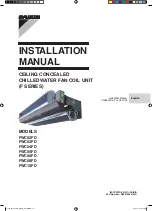
Nuaire Limited
Western Industrial Estate Caerphilly United Kingdom CF83 1NA
T: 029 2085 8400 F: 029 2085 8444 E: [email protected] W: www.nuaire.co.uk
1
The HPKF should be so positioned to give a minimum
distance of 650mm between the supporting surface for the
cooking vessel on the hob and the lowest part of the HPKF.
The exhaust air must not be discharged into a flue
which is used for exhausting fumes from appliances
burning gas or other fuels.
HPKF
High Performance Kitchen Fan
Installation and Maintenance
16. 06. 15. Leaflet Number 671116
The EMC Directive
2004/108/EC
The Low Voltage
directive
2006/95/EC
Fig 1. General view of unit.
1.0 Introduction
The Nuaire HPKF Kitchen Extract fan is designed to be
mounted on a wall within a kitchen. The unit contains two
fans, one of which runs continuously providing
‘trickle’ ventilation, and a boost speed operation which can
be triggered manually or automatically. Fig 1. shows a
general view of the unit.
The unit will exhaust through the wall (125mm dia. back
outlet) or alternatively through the adjacent ceiling (150mm
dia. top outlet).
A suitable spigot is supplied ready to fit in the users chosen
position following removal of the top knockout or back
aperture cover plate.
A washable metal grease filter is located in a recess on the
underside of the case and can easily be withdrawn for
cleaning.
LOW or HIGH ‘boost’ speed can be initiated manually by the
remote switch provided or automatically via the
integral adjustable thermostat or via an external trigger
such as ‘Cooker Miser’ (details on request).
Fig 2. The remote control switch.
Remote Control Switch
A remote switch is included which allows the user to select
auto or manual operation, and a high or low manual ‘boost’
speed (see fig 2).
NOTE: Caution! The control wiring carries 230V mains
voltage.
Thermostat (integral)
A thermostat control knob is located on the top face of the
unit. The range of adjustment is 0-60
o
C. The chosen
setting will dictate when the unit switches to ‘boost’ speed.
The thermostat only operates in auto mode.
The user can override the thermostat when required by
switching to manual, or can permanently disable the
thermostat by removing the BROWN link wire on the
control wiring panel if desired. (see fig 4).
Setting the ‘boost’ speed (auto mode only)
In ‘auto’ mode, the preferred ‘boost’ speed can be set for
LOW (half) or HIGH (full).
Note: in ‘manual’ mode the ‘boost’ speed is fixed HIGH (full)
The wiring connection panel is located under a removable
top mounted cover plate.
The RED link wire can be relocated to change the ‘auto’
mode LOW or HIGH boost setting (see fig 4)
.
2.0 Installation
Select and mark out a suitable mounting position. Note the
clearance between the top of the unit and the ceiling must
not be less than 150mm when fitted to allow manual
adjustment of the top mounted thermostat control and
sufficient room to allow removal of the electrical access
cover.
Select a mounting position for the remote control switch as
close to the unit as is practical.
Refer to dimensions drawing and cut a suitably sized hole
in the wall (125mm dia outlet) or ceiling (150mm dia. outlet)
to allow connection to any associated ductwork (by
others).
Drill and plug the three mounting position holes in the wall
as per fixing deOffer the unit up and screw into position






















